Nano-Enhanced Polymer Composite Materials: A Review of Current Advancements and Challenges
Abstract
1. Introduction
1.1. Nanomaterials
1.1.1. Organic Nanomaterials
1.1.2. Inorganic Nanomaterials
1.1.3. Carbon-Based Nanomaterials
1.1.4. Graphene (G)
1.1.5. Graphene Oxide (GO)
1.1.6. Carbon Nanotubes (CNTs)
1.1.7. Fullerene (F)
2. Recent Advances in Nano-Enhanced Composites
2.1. Mechanical Properties
2.2. Electrical Properties
2.3. Thermal Properties
2.4. Optical Properties
3. Challenges in Nanocomposite Development
3.1. Dispersibility
3.2. Compatibility
3.3. Production Cost
3.4. Environmental Impact
4. Applications of Nanocomposites
5. Future Outlook
6. Conclusions
Author Contributions
Funding
Data Availability Statement
Acknowledgments
Conflicts of Interest
References
- Hsissou, R.; Seghiri, R.; Benzekri, Z.; Hilali, M.; Rafik, M.; Elharfi, A. Polymer Composite Materials: A Comprehensive Review. Compos. Struct. 2021, 262, 113640. [Google Scholar] [CrossRef]
- Bhong, M.; Khan, T.K.H.; Devade, K.; Vijay Krishna, B.; Sura, S.; Eftikhaar, H.K.; Pal Thethi, H.; Gupta, N. Review of Composite Materials and Applications. Mater. Today Proc. 2023. [CrossRef]
- Fan, Q.; Duan, H.; Xing, X. A Review of Composite Materials for Enhancing Support, Flexibility and Strength in Exercise. Alex. Eng. J. 2024, 94, 90–103. [Google Scholar] [CrossRef]
- Bin Rashid, A.; Haque, M.; Islam, S.M.M.; Uddin Labib, K.M.R. Nanotechnology-Enhanced Fiber-Reinforced Polymer Composites: Recent Advancements on Processing Techniques and Applications. Heliyon 2024, 10, e24692. [Google Scholar] [CrossRef] [PubMed]
- Ali, Z.; Yaqoob, S.; Yu, J.; D’Amore, A. Critical Review on the Characterization, Preparation, and Enhanced Mechanical, Thermal, and Electrical Properties of Carbon Nanotubes and Their Hybrid Filler Polymer Composites for Various Applications. Compos. Part C Open Access 2024, 13, 100434. [Google Scholar] [CrossRef]
- Kausar, A. Polyurethane Composite Foams in High-Performance Applications: A Review. Polym. Plast. Technol. Eng. 2018, 57, 346–369. [Google Scholar] [CrossRef]
- Hassan, T.; Salam, A.; Khan, A.; Khan, S.U.; Khanzada, H.; Wasim, M.; Khan, M.Q.; Kim, I.S. Functional Nanocomposites and Their Potential Applications: A Review. J. Polym. Res. 2021, 28, 36. [Google Scholar] [CrossRef]
- Huang, S.; Wang, B.; Yan, L. Interphase and Interfacial Properties of Composite Materials. In Composite Materials Manufacturing, Properties and Applications; Elsevier: Amsterdam, The Netherlands, 2021; pp. 151–177. [Google Scholar] [CrossRef]
- Jiang, Y. Using Nano-Powders to Improve the Interfacial Bonding Strength of Carbon Fiber/Epoxy Composites. Fibers Polym. 2022, 23, 1431–1439. [Google Scholar] [CrossRef]
- Mekuye, B.; Abera, B. Nanomaterials: An Overview of Synthesis, Classification, Characterization, and Applications. Nano Sel. 2023, 4, 486–501. [Google Scholar] [CrossRef]
- Jagtiani, E. Advancements in Nanotechnology for Food Science and Industry. Food Front. 2022, 3, 56–82. [Google Scholar] [CrossRef]
- Yang, K.; Zhang, F.; Chen, Y.; Zhang, H.; Xiong, B.; Chen, H. Recent Progress on Carbon-Based Composites in Multidimensional Applications. Compos. Part A Appl. Sci. Manuf. 2022, 157, 106906. [Google Scholar] [CrossRef]
- Ma, H.; Geng, P.; Xu, T.; Kumar Bandaru, A.; Aravand, A.; Falzon, B.G. Analytical Fracture Toughness Model for Multiphase Epoxy Matrices Modified by Thermoplastic and Carbon Nanotube/Thermoplastic. Compos. Part A Appl. Sci. Manuf. 2024, 177, 107948. [Google Scholar] [CrossRef]
- Omanović-Mikličanin, E.; Badnjević, A.; Kazlagić, A.; Hajlovac, M. Nanocomposites: A Brief Review. Health Technol. 2020, 10, 51–59. [Google Scholar] [CrossRef]
- Qin, R.; Zhou, A.; Yu, Z.; Wang, Q.; Lau, D. Role of Carbon Nanotube in Reinforcing Cementitious Materials: An Experimental and Coarse-Grained Molecular Dynamics Study. Cem. Concr. Res. 2021, 147, 106517. [Google Scholar] [CrossRef]
- Qiu, L.; Zhu, N.; Feng, Y.; Michaelides, E.E.; Żyła, G.; Jing, D.; Zhang, X.; Norris, P.M.; Markides, C.N.; Mahian, O. A Review of Recent Advances in Thermophysical Properties at the Nanoscale: From Solid State to Colloids. Phys. Rep. 2020, 843, 1–81. [Google Scholar] [CrossRef]
- Kara, Y.; Acar, V.; Seydibeyoglu, M.O. Mechanical Properties of Nanoparticle-Based Polymer Composites. In Nanoparticle-Based Polymer Composites; Elsevier: Amsterdam, The Netherlands, 2022; pp. 95–108. [Google Scholar] [CrossRef]
- Xie, P.; Yuan, W.; Liu, X.; Peng, Y.; Yin, Y.; Li, Y.; Wu, Z. Advanced Carbon Nanomaterials for State-of-the-Art Flexible Supercapacitors. Energy Storage Mater. 2021, 36, 56–76. [Google Scholar] [CrossRef]
- Barako, M.T.; Gambin, V.; Tice, J. Integrated Nanomaterials for Extreme Thermal Management: A Perspective for Aerospace Applications. Nanotechnology 2018, 29, 154003. [Google Scholar] [CrossRef] [PubMed]
- Abbasi, S.; Peerzada, M.H.; Nizamuddin, S.; Mubarak, N.M. Functionalized Nanomaterials for the Aerospace, Vehicle, and Sports Industries. In Handbook of Functionalized Nanomaterials for Industrial Applications; Elsevier: Amsterdam, The Netherlands, 2020; pp. 795–825. [Google Scholar] [CrossRef]
- Bououdina, M.; Rashdan, S.; Bobet, J.L.; Ichiyanagi, Y. Nanomaterials for Biomedical Applications: Synthesis, Characterization, and Applications. J. Nanomater. 2013, 2013, 962384. [Google Scholar] [CrossRef]
- de Almeida Barcelos, K.; Garg, J.; Ferreira Soares, D.C.; de Barros, A.L.B.; Zhao, Y.; Alisaraie, L. Recent Advances in the Applications of CNT-Based Nanomaterials in Pharmaceutical Nanotechnology and Biomedical Engineering. J. Drug Deliv. Sci. Technol. 2023, 87, 104834. [Google Scholar] [CrossRef]
- Nandhini, J.; Karthikeyan, E.; Rajeshkumar, S. Nanomaterials for Wound Healing: Current Status and Futuristic Frontier. Biomed. Technol. 2024, 6, 26–45. [Google Scholar] [CrossRef]
- Patel, P.; Geed, S.R. Recent Advancements in the Application of Nanomaterial in Modern Drug Delivery and Future Perspective. In Environmental Science and Engineering; Springer International Publishing: Cham, Switzerland, 2024; Volume Part. [Google Scholar]
- Kumar, S.; Sarita; Nehra, M.; Dilbaghi, N.; Tankeshwar, K.; Kim, K.H. Recent Advances and Remaining Challenges for Polymeric Nanocomposites in Healthcare Applications. Prog. Polym. Sci. 2018, 80, 1–38. [Google Scholar] [CrossRef]
- Zein, M.A.; Asghar, B.H.; Almohyawi, A.M.; Alqahtani, N.F.; Alharbi, A.; Alkabli, J.; Elshaarawy, R.F.M.; Ismail, L.A. Multifunctional Nanocomposites Integrated Green Synthesized Amphiphilic Chitosan/Thyme Extract/Nanosilver for Antimicrobial and Anti-Biofilm Applications. React. Funct. Polym. 2024, 194, 105791. [Google Scholar] [CrossRef]
- Asha, A.B.; Narain, R. Nanomaterials Properties. In Polymer Science and Nanotechnology Fundamentals and Applications; Elsevier: Amsterdam, The Netherlands, 2020; pp. 343–359. [Google Scholar] [CrossRef]
- Joudeh, N.; Linke, D. Nanoparticle Classification, Physicochemical Properties, Characterization, and Applications: A Comprehensive Review for Biologists. J. Nanobiotechnol. 2022, 20, 262. [Google Scholar] [CrossRef] [PubMed]
- Hu, J.; Jiao, Z.; Han, X.; Liu, J.; Ma, M.; Jiang, J.; Hou, Y.; Wang, X.; Feng, C.; Ma, Y. Facile Synthesis of FeNi Nanoparticle-Loaded Carbon Nanocomposite Fibers for Enhanced Microwave Absorption Performance. J. Mater. Sci. Technol. 2024, 175, 141–152. [Google Scholar] [CrossRef]
- Cai, Y.; Chen, Z.; Wang, S.; Chen, J.; Hu, B.; Shen, C.; Wang, X. Carbon-Based Nanocomposites for the Elimination of Inorganic and Organic Pollutants through Sorption and Catalysis Strategies. Sep. Purif. Technol. 2023, 308, 122862. [Google Scholar] [CrossRef]
- Venkateswara Raju, C.; Hwan Cho, C.; Mohana Rani, G.; Manju, V.; Umapathi, R.; Suk Huh, Y.; Pil Park, J. Emerging Insights into the Use of Carbon-Based Nanomaterials for the Electrochemical Detection of Heavy Metal Ions. Coord. Chem. Rev. 2023, 476, 214920. [Google Scholar] [CrossRef]
- Wang, M.; Yang, J.; You, X.; Liao, C.; Yan, J.; Ruan, J.; Dong, S. Nanoinfiltration Behavior of Carbon Nanotube Based Nanocomposites with Enhanced Mechanical and Electrical Properties. J. Mater. Sci. Technol. 2021, 71, 23–30. [Google Scholar] [CrossRef]
- Chowdhury, M.I.S.; Autul, Y.S.; Rahman, S.; Hoque, M.E. Polymer Nanocomposites for Automotive Applications. In Advanced Polymer Nanocomposites Science, Technology and Applications; Woodhead Publishing in Materials: Sawston, UK, 2022; pp. 267–317. [Google Scholar] [CrossRef]
- Jafarzadeh, S.; Jafari, S.M. Impact of Metal Nanoparticles on the Mechanical, Barrier, Optical and Thermal Properties of Biodegradable Food Packaging Materials. Crit. Rev. Food Sci. Nutr. 2020, 61, 2640–2658. [Google Scholar] [CrossRef]
- Yashas Gowda, T.G.; Mavinkere Rangappa, S.; Siengchin, S.; Parameswaranpillai, J. Introduction to Nanoparticle-Based Materials and Their Composites. In Nanoparticle-Based Polymer Composites; Woodhead Publishing in Materials: Sawston, UK, 2022; pp. 1–14. [Google Scholar] [CrossRef]
- Guan, L.Z.; Tang, L.C. Dispersion and Alignment of Carbon Nanotubes in Polymer Matrix. In Handbook of Carbon Nanotubes; Springer International Publishing: Cham, Switzerland, 2022. [Google Scholar]
- Zhang, Z.; Du, J.; Li, J.; Huang, X.; Kang, T.; Zhang, C.; Wang, S.; Ajao, O.O.; Wang, W.J.; Liu, P. Polymer Nanocomposites with Aligned Two-Dimensional Materials. Prog. Polym. Sci. 2021, 114, 101360. [Google Scholar] [CrossRef]
- Khan, I.; Saeed, K.; Khan, I. Nanoparticles: Properties, Applications and Toxicities. Arab. J. Chem. 2019, 12, 908–931. [Google Scholar] [CrossRef]
- Rizwan, M.; Shoukat, A.; Ayub, A.; Razzaq, B.; Tahir, M.B. Types and Classification of Nanomaterials. In Nanomaterials: Synthesis, Characterization, Hazards and Safety; Elsevier: Amsterdam, The Netherlands, 2021; pp. 31–54. [Google Scholar] [CrossRef]
- Majhi, K.C.; Yadav, M. Synthesis of Inorganic Nanomaterials Using Carbohydrates. In Green Sustainable Process for Chemical and Environmental Engineering and Science Green Inorganic Synthesis; Elsevier: Amsterdam, The Netherlands, 2021; pp. 109–135. [Google Scholar] [CrossRef]
- Tshikovhi, A.; Mishra, S.B.; Mishra, A.K. Nanocellulose-Based Composites for the Removal of Contaminants from Wastewater. Int. J. Biol. Macromol. 2020, 152, 616–632. [Google Scholar] [CrossRef] [PubMed]
- Colorado, H.A.; Gutierrez-Velasquez, E.I.; Gil, L.D.; de Camargo, I.L. Exploring the Advantages and Applications of Nanocomposites Produced via Vat Photopolymerization in Additive Manufacturing: A Review. Adv. Compos. Hybrid Mater. 2024, 7, 1. [Google Scholar] [CrossRef]
- Nurazzi, N.M.; Bayraktar, E.; Norrrahim, M.N.F.; Aisyah, H.A.; Abdullah, N.; Asyraf, M.R.M. Nanofillers for Sustainable Applications; CRC Press: Boca Raton, FL, USA, 2023. [Google Scholar]
- Khan, T.; Chauhan, A. Polymer-Based Bionanomaterials for Biomedical Applications. In Bionanotechnology: Emerging Applications of Bionanomaterials; Elsevier: Amsterdam, The Netherlands, 2022; pp. 187–225. [Google Scholar] [CrossRef]
- Singh, V.; Yadav, P.; Mishra, V. Recent Advances on Classification, Properties, Synthesis, and Characterization of Nanomaterials. In Green Synthesis of Nanomaterials for Bioenergy Applications; John Wiley & Sons: Hoboken, NJ, USA, 2020. [Google Scholar]
- Husen, A.; Siddiqi, K.S. Advances in Smart Nanomaterials and Their Applications; Elsevier: Amsterdam, The Netherlands, 2023. [Google Scholar]
- Kumar, N.; Sinha Ray, S. Synthesis and Functionalization of Nanomaterials. In Processing of Polymer-Based Nanocomposites: Introduction; Springer Series in Materials Science; Springer: Cham, Switzerland, 2018. [Google Scholar]
- Dhand, C.; Dwivedi, N.; Loh, X.J.; Jie Ying, A.N.; Verma, N.K.; Beuerman, R.W.; Lakshminarayanan, R.; Ramakrishna, S. Methods and Strategies for the Synthesis of Diverse Nanoparticles and Their Applications: A Comprehensive Overview. RSC Adv. 2015, 5, 105003–105037. [Google Scholar] [CrossRef]
- Kumar, S.; Singhal, A.; Narang, U.; Mishra, S.; Kumari, P. Recent Progresses in Organic-Inorganic Nano Technological Platforms for Cancer Therapeutics. Curr. Med. Chem. 2018, 27, 6015–6056. [Google Scholar] [CrossRef] [PubMed]
- Najafi, F.; Salami-Kalajahi, M.; Roghani-Mamaqani, H. A Review on Synthesis and Applications of Dendrimers. J. Iran. Chem. Soc. 2021, 18, 503–517. [Google Scholar] [CrossRef]
- Pandey, J.; Dubey, R.; Kate, A.; Prasad, B.; Sinha, A.; Mishra, M.S. Nanomedicines: A Focus on Nanomaterials as Drug Delivery System with Current Trends and Future Advancement. Drug Res. 2022, 72, 355–366. [Google Scholar] [CrossRef]
- Thakur, V.; Guleria, A.; Kumar, S.; Sharma, S.; Singh, K. Recent Advances in Nanocellulose Processing, Functionalization and Applications: A Review. Mater. Adv. 2021, 2, 1872–1895. [Google Scholar] [CrossRef]
- Ribeiro, R.S.A.; Pohlmann, B.C.; Calado, V.; Bojorge, N.; Pereira, N. Production of Nanocellulose by Enzymatic Hydrolysis: Trends and Challenges. Eng. Life Sci. 2019, 19, 279–291. [Google Scholar] [CrossRef]
- Kumar, V.V.; Anthony, S.P. Antimicrobial Studies of Metal and Metal Oxide Nanoparticles. In Surface Chemistry of Nanobiomaterials Applications of Nanobiomaterials; William Andrew Publishing: Norwich, UK, 2016; pp. 265–300. [Google Scholar] [CrossRef]
- Chandrasekar, M.; Kumar, T.S.M.; Senthilkumar, K.; Nurazzi, N.M.; Sanjay, M.R.; Rajini, N.; Siengchin, S. Inorganic Nanofillers-Based Thermoplastic and Thermosetting Composites. In Lightweight Polymer Composite Structures; CRC Press: Boca Raton, FL, USA, 2020. [Google Scholar]
- Ahmad, M.; Riaz, U.; Iqbal, S.; Rasheed, H.; Mousa Mousa, M.A.; Al-Farraj, A.S.F.; Al-Wabel, M.I. Advances in the Development and Applications of Clay-Based Composites. In Clay Composites: Environmental Applications; Springer Nature: Singapore, 2023. [Google Scholar]
- Bulut, M.; Bozkurt, Ö.Y.; Erkliğ, A.; Yaykaşlı, H.; Özbek, Ö. Mechanical and Dynamic Properties of Basalt Fiber-Reinforced Composites with Nanoclay Particles. Arab. J. Sci. Eng. 2020, 45, 1017–1033. [Google Scholar] [CrossRef]
- Nasir, S.; Hussein, M.Z.; Zainal, Z.; Yusof, N.A. Carbon-Based Nanomaterials/Allotropes: A Glimpse of Their Synthesis, Properties and Some Applications. Materials 2018, 11, 295. [Google Scholar] [CrossRef]
- Geng, H.; Peng, Y.; Qu, L.; Zhang, H.; Wu, M. Structure Design and Composition Engineering of Carbon-Based Nanomaterials for Lithium Energy Storage. Adv. Energy Mater. 2020, 10, 1903030. [Google Scholar] [CrossRef]
- Karaca, B.; Karataş, Y.; Cakar, A.B.; Gülcan, M.; Şen, F. Carbon-Based Nanostructures and Nanomaterials. In Nanoscale Processing; Elsevier: Amsterdam, The Netherlands, 2021; pp. 103–130. [Google Scholar] [CrossRef]
- Siqueira, J.R.; Oliveira, O.N. Carbon-Based Nanomaterials. In Nanostructures; William Andrew Publishing: Norwich, UK, 2017; pp. 233–249. [Google Scholar] [CrossRef]
- Rao, N.; Singh, R.; Bashambu, L. Carbon-Based Nanomaterials: Synthesis and Prospective Applications. Mater. Today Proc. 2021, 44, 608–614. [Google Scholar] [CrossRef]
- Joshi, A.; Kim, K.H. Recent Advances in Nanomaterial-Based Electrochemical Detection of Antibiotics: Challenges and Future Perspectives. Biosens. Bioelectron. 2020, 153, 112046. [Google Scholar]
- Mittal, G.; Rhee, K.Y.; Mišković-Stanković, V.; Hui, D. Reinforcements in Multi-Scale Polymer Composites: Processing, Properties, and Applications. Compos. Part B Eng. 2018, 138, 122–139. [Google Scholar] [CrossRef]
- Ibrahim, A.; Klopocinska, A.; Horvat, K.; Hamid, Z.A. Graphene-Based Nanocomposites: Synthesis, Mechanical Properties, and Characterizations. Polymers 2021, 13, 2869. [Google Scholar] [CrossRef] [PubMed]
- Goenka, S.; Sant, V.; Sant, S. Graphene-Based Nanomaterials for Drug Delivery and Tissue Engineering. J. Control. Release 2014, 173, 75–88. [Google Scholar] [CrossRef] [PubMed]
- Madurani, K.A.; Suprapto, S.; Machrita, N.I.; Bahar, S.L.; Illiya, W.; Kurniawan, F. Progress in Graphene Synthesis and Its Application: History, Challenge and the Future Outlook for Research and Industry. ECS J. Solid State Sci. Technol. 2020, 9, 093013. [Google Scholar] [CrossRef]
- De Leon, A.C.; Chen, Q.; Palaganas, N.B.; Palaganas, J.O.; Manapat, J.; Advincula, R.C. High Performance Polymer Nanocomposites for Additive Manufacturing Applications. React. Funct. Polym. 2016, 103, 141–155. [Google Scholar]
- Pena-Pereira, F.; Romero, V.; de la Calle, I.; Lavilla, I.; Bendicho, C. Graphene-Based Nanocomposites in Analytical Extraction Processes. TrAC Trends Anal. Chem. 2021, 142, 116303. [Google Scholar] [CrossRef]
- Dahiya, M.; Bansal, S.A. Graphene-Reinforced Nanocomposites: Synthesis, Micromechanics Models, Analysis and Applications—A Review. Proc. Inst. Mech. Eng. Part C J. Mech. Eng. Sci. 2022, 236, 9218–9240. [Google Scholar] [CrossRef]
- Khine, Y.Y.; Wen, X.; Jin, X.; Foller, T.; Joshi, R. Functional Groups in Graphene Oxide. Phys. Chem. Chem. Phys. 2022, 24, 26337–26355. [Google Scholar] [CrossRef] [PubMed]
- Yu, W.; Sisi, L.; Haiyan, Y.; Jie, L. Progress in the Functional Modification of Graphene/Graphene Oxide: A Review. RSC Adv. 2020, 10, 15328–15345. [Google Scholar] [CrossRef] [PubMed]
- Khan, M.B.; Parvaz, M.; Khan, Z.H. Graphene Oxide: Synthesis and Characterization. In Advanced Structured Materials; Springer: Singapore, 2017; Volume 83. [Google Scholar]
- Loudiki, A.; Matrouf, M.; Azriouil, M.; Laghrib, F.; Farahi, A.; Bakasse, M.; Lahrich, S.; El Mhammedi, M.A. Graphene Oxide Synthesized from Zinc-Carbon Battery Waste Using a New Oxidation Process Assisted Sonication: Electrochemical Properties. Mater. Chem. Phys. 2022, 275, 125308. [Google Scholar] [CrossRef]
- Chinthala, M.; Balakrishnan, A.; Venkataraman, P.; Manaswini Gowtham, V.; Polagani, R.K. Synthesis and Applications of Nano-MgO and Composites for Medicine, Energy, and Environmental Remediation: A Review. Environ. Chem. Lett. 2021, 19, 4415–4454. [Google Scholar] [CrossRef]
- Gandhi, M.R.; Vasudevan, S.; Shibayama, A.; Yamada, M. Graphene and Graphene-Based Composites: A Rising Star in Water Purification—A Comprehensive Overview. ChemistrySelect 2016, 1, 4358–4385. [Google Scholar] [CrossRef]
- Wang, Y.; Pan, C.; Chu, W.; Vipin, A.K.; Sun, L. Environmental Remediation Applications of Carbon Nanotubes and Graphene Oxide: Adsorption and Catalysis. Nanomaterials 2019, 9, 439. [Google Scholar] [CrossRef]
- Kiran, I.; Shad, N.A.; Sajid, M.M.; Jamil, Y.; Javed, Y.; Hussain, M.I.; Akhtar, K. Graphene Functionalized PLA Nanocomposites and Their Biomedical Applications. In Graphene Based Biopolymer Nanocomposites; Springer: Singapore, 2021. [Google Scholar]
- Farjadian, F.; Abbaspour, S.; Sadatlu, M.A.A.; Mirkiani, S.; Ghasemi, A.; Hoseini-Ghahfarokhi, M.; Mozaffari, N.; Karimi, M.; Hamblin, M.R. Recent Developments in Graphene and Graphene Oxide: Properties, Synthesis, and Modifications: A Review. ChemistrySelect 2020, 5, 10200–10219. [Google Scholar] [CrossRef]
- Yang, S.; Shin, H.; Cho, M. Contribution of Oxygen Functional Groups in Graphene to the Mechanical and Interfacial Behaviour of Nanocomposites: Molecular Dynamics and Micromechanics Study. Int. J. Mech. Sci. 2021, 189, 105972. [Google Scholar] [CrossRef]
- Sharotri, N.; Rana, A.K.; Neha; Thakur, N.; Dogra, S.; Dhiman, N. Fundamental of Graphene Nanocomposites. In Handbook of Polymer and Eramic Nanotechnology: Volume 1,2; Springer: Cham, Switzerland, 2021; Volume 2. [Google Scholar]
- Srikanth, N.; Kumar, A.C. History of Carbon Nanotubes. In Handbook of Carbon Nanotubes; Springer International Publishing: Cham, Switzerland, 2022. [Google Scholar]
- Rahamathulla, M.; Bhosale, R.R.; Osmani, R.A.M.; Mahima, K.C.; Johnson, A.P.; Hani, U.; Ghazwani, M.; Begum, M.Y.; Alshehri, S.; Ghoneim, M.M.; et al. Carbon Nanotubes: Current Perspectives on Diverse Applications in Targeted Drug Delivery and Therapies. Materials 2021, 14, 6707. [Google Scholar] [CrossRef]
- Zhang, X.; Lu, W.; Zhou, G.; Li, Q. Understanding the Mechanical and Conductive Properties of Carbon Nanotube Fibers for Smart Electronics. Adv. Mater. 2020, 32, 1902028. [Google Scholar] [CrossRef]
- Anzar, N.; Hasan, R.; Tyagi, M.; Yadav, N.; Narang, J. Carbon Nanotube—A Review on Synthesis, Properties and Plethora of Applications in the Field of Biomedical Science. Sens. Int. 2020, 1, 100003. [Google Scholar] [CrossRef]
- Lavagna, L.; Nisticò, R.; Musso, S.; Pavese, M. Functionalization as a Way to Enhance Dispersion of Carbon Nanotubes in Matrices: A Review. Mater. Today Chem. 2021, 20, 100477. [Google Scholar] [CrossRef]
- Wu, Y.; Zhao, X.; Shang, Y.; Chang, S.; Dai, L.; Cao, A. Application-Driven Carbon Nanotube Functional Materials. ACS Nano 2021, 15, 7946–7974. [Google Scholar] [CrossRef] [PubMed]
- Nimibofa, A.; Newton, E.A.; Cyprain, A.Y.; Donbebe, W. Fullerenes: Synthesis and Applications. J. Mater. Sci. Res. 2018, 7, 22–33. [Google Scholar] [CrossRef]
- Baskar, A.V.; Benzigar, M.R.; Talapaneni, S.N.; Singh, G.; Karakoti, A.S.; Yi, J.; Al-Muhtaseb, A.H.; Ariga, K.; Ajayan, P.M.; Vinu, A. Self-Assembled Fullerene Nanostructures: Synthesis and Applications. Adv. Funct. Mater. 2022, 32, 2106924. [Google Scholar] [CrossRef]
- Saadh, M.J.; Al-dolaimy, F.; Alamir, H.T.A.; Kadhim, O.; Al-Abdeen, S.H.Z.; Sattar, R.; Mhussan Jabbar, A.; Kadhem Abid, M.; Jetti, R.; Alawadi, A.; et al. Emerging Pathways in Environmentally Friendly Synthesis of Carbon-Based Quantum Dots for Exploring Antibacterial Resistance. Inorg. Chem. Commun. 2024, 161, 112012. [Google Scholar] [CrossRef]
- Ghosh, P.; Deepshikha, K.; Kumar, R.R.; Chaturvedi, V.; Verma, P. Recent Advances of Nanotechnology in Ameliorating Bioenergy Production: A Comprehensive Review. Sustain. Chem. Pharm. 2024, 37, 101392. [Google Scholar] [CrossRef]
- Rahman, M.; Islam, K.S.; Dip, T.M.; Chowdhury, M.F.M.; Debnath, S.R.; Hasan, S.M.M.; Sakib, M.S.; Saha, T.; Padhye, R.; Houshyar, S. A Review on Nanomaterial-Based Additive Manufacturing: Dynamics in Properties, Prospects, and Challenges. Prog. Addit. Manuf. 2023, 9, 1197–1224. [Google Scholar] [CrossRef]
- Rahnamol, A.M.; Gopalakrishnan, J. Improved Dielectric and Dynamic Mechanical Properties of Epoxy/Polyaniline Nanorod/in Situ Reduced Graphene Oxide Hybrid Nanocomposites. Polym. Compos. 2020, 41, 2998–3013. [Google Scholar] [CrossRef]
- Kausar, A. Fullerene Reinforced Polymeric Nanocomposites for Energy Storage—Status and Prognoses. Front. Mater. 2022, 9, 874169. [Google Scholar] [CrossRef]
- Ajay Kumar, P.; Vishnu Namboodiri, V.; Joshi, G.; Mehta, K.P. Fabrication and Applications of Fullerene-Based Metal Nanocomposites: A Review. J. Mater. Res. 2021, 36, 114–128. [Google Scholar]
- Jani, M.; Arcos-Pareja, J.A.; Ni, M. Engineered Zero-Dimensional Fullerene/Carbon Dots-Polymer Based Nanocomposite Membranes for Wastewater Treatment. Molecules 2020, 25, 4934. [Google Scholar] [CrossRef] [PubMed]
- Ng, L.Y.; Chua, H.S.; Ng, C.Y. Incorporation of Graphene Oxide-Based Nanocomposite in the Polymeric Membrane for Water and Wastewater Treatment: A Review on Recent Development. J. Environ. Chem. Eng. 2021, 9, 105994. [Google Scholar] [CrossRef]
- Wang, T.; Yu, W.C.; Zhou, C.G.; Sun, W.J.; Zhang, Y.P.; Jia, L.C.; Gao, J.F.; Dai, K.; Yan, D.X.; Li, Z.M. Self-Healing and Flexible Carbon Nanotube/Polyurethane Composite for Efficient Electromagnetic Interference Shielding. Compos. Part B Eng. 2020, 193, 108015. [Google Scholar] [CrossRef]
- Arif, Z.U.; Khalid, M.Y.; Sheikh, M.F.; Zolfagharian, A.; Bodaghi, M. Biopolymeric Sustainable Materials and Their Emerging Applications. J. Environ. Chem. Eng. 2022, 10, 108159. [Google Scholar] [CrossRef]
- Gowthaman, N.S.K.; Lim, H.N.; Sreeraj, T.R.; Amalraj, A.; Gopi, S. Advantages of Biopolymers over Synthetic Polymers: Social, Economic, and Environmental Aspects. In Biopolymers and Their Industrial Applications; Elsevier: Amsterdam, The Netherlands, 2021. [Google Scholar]
- Baranwal, J.; Barse, B.; Fais, A.; Delogu, G.L.; Kumar, A. Biopolymer: A Sustainable Material for Food and Medical Applications. Polymers 2022, 14, 983. [Google Scholar] [CrossRef]
- Al, G.; Aydemir, D.; Kaygin, B.; Ayrilmis, N.; Gunduz, G. Preparation and Characterization of Biopolymer Nanocomposites from Cellulose Nanofibrils and Nanoclays. J. Compos. Mater. 2018, 52, 689–700. [Google Scholar] [CrossRef]
- Xie, D.; Zhang, R.; Zhang, C.; Yang, S.; Xu, Z.; Song, Y. A Novel, Robust Mechanical Strength, and Naturally Degradable Double Crosslinking Starch-Based Bioplastics for Practical Applications. Int. J. Biol. Macromol. 2023, 253, 126959. [Google Scholar] [CrossRef]
- Martínez-Rubio, P.M.; Avilés, M.D.; Pamies, R.; Benítez-Benítez, S.J.; Arribas, A.; Carrión-Vilches, F.J.; Bermúdez, M.D. In-Depth Analysis of the Complex Interactions Induced by Nanolayered Additives in PHBV Nanocomposites. Macromol. Mater. Eng. 2024, 309, 2400016. [Google Scholar] [CrossRef]
- Ancy, A.; Lazar, M.; Saritha Chandran, A.; Ushamani, M. Development of Ecofriendly and Sustainable Bioplastics from Cassava Starch: Tailoring the Properties Using Nanoparticles. Sustain. Chem. Pharm. 2024, 37, 101377. [Google Scholar] [CrossRef]
- Srisuwan, Y.; Srihanam, P.; Rattanasuk, S.; Baimark, Y. Preparation of Poly(L-Lactide)-b-Poly(Ethylene Glycol)-b-Poly(L-Lactide)/Zinc Oxide Nanocomposite Bioplastics for Potential Use as Flexible and Antibacterial Food Packaging. Polymers 2024, 16, 1660. [Google Scholar] [CrossRef] [PubMed]
- Paszkiewicz, S.; Walkowiak, K.; Barczewski, M. Biobased Polymer Nanocomposites Prepared by in Situ Polymerization: Comparison between Carbon and Mineral Nanofillers. J. Mater. Sci. 2024, 59, 13805–13823. [Google Scholar] [CrossRef]
- Uddin, M.N.; Hossain, M.T.; Mahmud, N.; Aalm, S.; Joaber, M.; Mahedi, S.I.; Ali, A. Research and Applications of Nanoclays: A Review. SPE Polym. 2024, 1–29. [Google Scholar] [CrossRef]
- Cheon, J.; Kim, M. Impact Resistance and Interlaminar Shear Strength Enhancement of Carbon Fiber Reinforced Thermoplastic Composites by Introducing MWCNT-Anchored Carbon Fiber. Compos. Part B Eng. 2021, 217, 108872. [Google Scholar] [CrossRef]
- Abutalib, M.M.; Rajeh, A. Enhanced Structural, Electrical, Mechanical Properties and Antibacterial Activity of Cs/PEO Doped Mixed Nanoparticles (Ag/TiO2) for Food Packaging Applications. Polym. Test. 2021, 93, 107013. [Google Scholar] [CrossRef]
- Govindan, K.; Ramabalan, S.; Vishvanathperumal, S. Enhancement of Mechanical Performance and Swelling Resistance in Silicone Rubber Through Reinforcement with γ-Methacryloxypropyltrimethoxysilane-Modified Halloysite Nanotubes. J. Inorg. Organomet. Polym. Mater. 2024, 34, 2242–2259. [Google Scholar] [CrossRef]
- Wu, Z.; Zhao, Y.; Yang, K.; Guan, J.; Wang, S.; Gu, Y.; Li, M.; Feng, Y.; Feng, W.; Ritchie, R.O. Enhancing the Mechanical Performance of Fiber-Reinforced Polymer Composites Using Carbon Nanotubes as an Effective Nano-Phase Reinforcement. Adv. Mater. Interfaces 2023, 10, 2201935. [Google Scholar] [CrossRef]
- Sarkar, L.; Saha, S.; Samanta, R.; Sinha, A.; Mandal, G.; Biswas, A.; Das, A. Recent Progress in CNT-Reinforced Composite and FGM for Multi-Functional Space Applications and Future Directions. J. Inst. Eng. Ser. D 2024, 105, 527–541. [Google Scholar] [CrossRef]
- Chen, B.; Zhou, X.Y.; Zhang, B.; Kondoh, K.; Li, J.S.; Qian, M. Microstructure, Tensile Properties and Deformation Behaviors of Aluminium Metal Matrix Composites Co-Reinforced by Ex-Situ Carbon Nanotubes and in-Situ Alumina Nanoparticles. Mater. Sci. Eng. A 2020, 795, 139930. [Google Scholar] [CrossRef]
- Ma, Q.; Xing, D.; Hao, B.; Ma, P.C. Interfacial Engineering Strategy to Improve the Piezoresistive Performance of Polymer Nanocomposites via Chemical Bonding of Carbon Nanotubes on Graphene. Compos. Part A Appl. Sci. Manuf. 2023, 174, 107730. [Google Scholar] [CrossRef]
- Farshidfar, A.; Bazgir, S.; Katbab, A.A.; Vaziri, A. Manipulation of Mechanical and Thermal Properties of Graphene Oxide/Nanoclay/Unsaturated Polyester Hybrid Nanocomposites by the Surface Chemistry and Nanofiller Composition. Polym. Test. 2023, 120, 107951. [Google Scholar] [CrossRef]
- Wijerathne, D.; Gong, Y.; Afroj, S.; Karim, N.; Abeykoon, C. Mechanical and Thermal Properties of Graphene Nanoplatelets-Reinforced Recycled Polycarbonate Composites. Int. J. Light. Mater. Manuf. 2023, 6, 117–128. [Google Scholar] [CrossRef]
- Abbass, A.; Paiva, M.C.; Oliveira, D.V.; Lourenço, P.B.; Fangueiro, R. Graphene/Polyurethane Nanocomposite Coatings—Enhancing the Mechanical Properties and Environmental Resistance of Natural Fibers for Masonry Retrofitting. Compos. Part A Appl. Sci. Manuf. 2023, 166, 107379. [Google Scholar] [CrossRef]
- Katagiri, K.; Kishimoto, N.; Okumura, T.; Kawakita, S.; Honda, S.; Sasaki, K. Effects of Cellulose Nanofiber Content on Impact Properties of Carbon Fiber Reinforced Epoxy Composites with the Cellulose Nanofiber Dispersion Layer. Mech. Adv. Mater. Struct. 2022, 29, 6087–6095. [Google Scholar] [CrossRef]
- Cherian, B.M.; Leão, A.L.; De Souza, S.F.; Costa, L.M.M.; De Olyveira, G.M.; Kottaisamy, M.; Nagarajan, E.R.; Thomas, S. Cellulose Nanocomposites with Nanofibres Isolated from Pineapple Leaf Fibers for Medical Applications. Carbohydr. Polym. 2011, 86, 1790–1798. [Google Scholar] [CrossRef]
- Ansari, F.; Skrifvars, M.; Berglund, L. Nanostructured Biocomposites Based on Unsaturated Polyester Resin and a Cellulose Nanofiber Network. Compos. Sci. Technol. 2015, 117, 298–306. [Google Scholar] [CrossRef]
- Lee, K.Y.; Ho, K.K.C.; Schlufter, K.; Bismarck, A. Hierarchical Composites Reinforced with Robust Short Sisal Fibre Preforms Utilising Bacterial Cellulose as Binder. Compos. Sci. Technol. 2012, 72, 1479–1486. [Google Scholar] [CrossRef]
- Kostagiannakopoulou, C.; Tsilimigkra, X.; Sotiriadis, G.; Kostopoulos, V. Synergy Effect of Carbon Nano-Fillers on the Fracture Toughness of Structural Composites. Compos. Part B Eng. 2017, 129, 18–25. [Google Scholar] [CrossRef]
- Ary Subagia, I.D.G.; Tijing, L.D.; Kim, Y.; Kim, C.S.; Vista Iv, F.P.; Shon, H.K. Mechanical Performance of Multiscale Basalt Fiber-Epoxy Laminates Containing Tourmaline Micro/Nano Particles. Compos. Part B Eng. 2014, 58, 611–617. [Google Scholar] [CrossRef]
- Zhu, X.; Li, Y.; Yu, T.; Zhang, Z. Enhancement of the Interlaminar Fracture Toughness and Damping Properties of Carbon Fiber Reinforced Composites Using Cellulose Nanofiber Interleaves. Compos. Commun. 2021, 28, 100940. [Google Scholar] [CrossRef]
- Coetzee, D.; Venkataraman, M.; Militky, J.; Petru, M. Influence of Nanoparticles on Thermal and Electrical Conductivity of Composites. Polymers 2020, 12, 742. [Google Scholar] [CrossRef]
- Szczech, J.R.; Higgins, J.M.; Jin, S. Enhancement of the Thermoelectric Properties in Nanoscale and Nanostructured Materials. J. Mater. Chem. 2011, 21, 4037–4055. [Google Scholar] [CrossRef]
- Abbasi, H.; Antunes, M.; Velasco, J.I. Recent Advances in Carbon-Based Polymer Nanocomposites for Electromagnetic Interference Shielding. Prog. Mater. Sci. 2019, 103, 319–373. [Google Scholar] [CrossRef]
- Izzati, W.A.; Arief, Y.Z.; Adzis, Z.; Shafanizam, M. Partial Discharge Characteristics of Polymer Nanocomposite Materials in Electrical Insulation: A Review of Sample Preparation Techniques, Analysis Methods, Potential Applications, and Future Trends. Sci. World J. 2014, 2014, 735070. [Google Scholar] [CrossRef] [PubMed]
- Wu, G.; Chen, Y.; Zhan, H.; Chen, H.T.; Lin, J.H.; Wang, J.N.; Wan, L.Q.; Huang, F.R. Ultrathin and Flexible Carbon Nanotube/Polymer Composite Films with Excellent Mechanical Strength and Electromagnetic Interference Shielding. Carbon 2020, 158, 472–480. [Google Scholar] [CrossRef]
- Dubey, P.; Gupta, M.; Kundalwal, S.I. Conductive Polymer Nanocomposite Incorporated with Carbon Nanotubes for Effective Electromagnetic Interference Shielding: A Numerical Study. Polym. Compos. 2024, 45, 3576–3590. [Google Scholar] [CrossRef]
- Zhang, S.; Yin, S.; Rong, C.; Huo, P.; Jiang, Z.; Wang, G. Synergistic Effects of Functionalized Graphene and Functionalized Multi-Walled Carbon Nanotubes on the Electrical and Mechanical Properties of Poly(Ether Sulfone) Composites. Eur. Polym. J. 2013, 49, 3125–3134. [Google Scholar] [CrossRef]
- He, Z.; Zhang, X.; Chen, M.; Li, M.; Gu, Y.; Zhang, Z.; Li, Q. Effect of the Filler Structure of Carbon Nanomaterials on the Electrical, Thermal, and Rheological Properties of Epoxy Composites. J. Appl. Polym. Sci. 2013, 129, 3366–3372. [Google Scholar] [CrossRef]
- He, S.; Zhang, J.; Xiao, X.; Hong, X.; Lai, Y. Investigation of the Conductive Network Formation of Polypropylene/Graphene Nanoplatelets Composites for Different Platelet Sizes. J. Mater. Sci. 2017, 52, 13103–13119. [Google Scholar] [CrossRef]
- Hassan, A.; Quanfang, C.; Abbas, S.; Akbar, H.; Youming, L.; Jie, L. Exploring the Electrical Performance of Advanced and Environmental-Friendly Novel Nanomaterial Wires in Generator Winding through Finite Element Analysis. J. Comput. Electron. 2023, 22, 17–28. [Google Scholar] [CrossRef]
- Zhang, F.; Feng, Y.; Feng, W. Three-Dimensional Interconnected Networks for Thermally Conductive Polymer Composites: Design, Preparation, Properties, and Mechanisms. Mater. Sci. Eng. R. Rep. 2020, 142, 100580. [Google Scholar] [CrossRef]
- Burger, N.; Laachachi, A.; Ferriol, M.; Lutz, M.; Toniazzo, V.; Ruch, D. Review of Thermal Conductivity in Composites: Mechanisms, Parameters and Theory. Prog. Polym. Sci. 2016, 61, 1–28. [Google Scholar] [CrossRef]
- Ujah, C.O.; Popoola, A.P.I.; Popoola, O.M.; Aigbodion, V.S. Enhanced Tribology, Thermal and Electrical Properties of Al-CNT Composite Processed via Spark Plasma Sintering for Transmission Conductor. J. Mater. Sci. 2019, 54, 14064–14073. [Google Scholar] [CrossRef]
- Ali, M.A.; Fayaz; Viegas, R.F.; Shyam Kumar, M.B.; Kannapiran, R.K.; Feroskhan, M. Enhancement of Heat Transfer in Paraffin Wax PCM Using Nano Graphene Composite for Industrial Helmets. J. Energy Storage 2019, 26, 100982. [Google Scholar] [CrossRef]
- Zhang, Z.; Wu, D.; Yang, H.; Qu, H.; Yao, C.; Liu, F.; Yu, P.; Yao, J.; You, F.; Jiang, X. Remarkable Enhancement in Thermal Performance of Polypropylene Carbonate by Using Exfoliated Boron Nitride Nanosheets. Chem. Eng. J. 2022, 450, 138247. [Google Scholar] [CrossRef]
- Bertolino, V.; Cavallaro, G.; Milioto, S.; Parisi, F.; Lazzara, G. Thermal Properties of Multilayer Nanocomposites Based on Halloysite Nanotubes and Biopolymers. J. Compos. Sci. 2018, 2, 41. [Google Scholar] [CrossRef]
- Zhang, B.; Wang, L.; Zhang, C.; Wu, S. High-Performance Cellulose Nanofiber-Derived Composite Films for Efficient Thermal Management of Flexible Electronic Devices. Chem. Eng. J. 2022, 439, 135675. [Google Scholar] [CrossRef]
- Haghighi, A.; Babapoor, A.; Azizi, M.; Javanshir, Z. Optimization of the Thermal Performance of PCM Nanocomposites. J. Energy Manag. Technol. 2020, 4, 14–19. [Google Scholar]
- Alotaibi, M.; Alsuhybani, M.; Khayyat, M.; Alotaibi, B. Performance of Nanocomposites of a Phase Change Material Formed by the Dispersion of MWCNT/TiO2 for Thermal Energy Storage Applications. Materials 2022, 15, 3063. [Google Scholar] [CrossRef]
- Huang, G.; Chen, W.; Wu, T.; Guo, H.; Fu, C.; Xue, Y.; Wang, K.; Song, P. Multifunctional Graphene-Based Nano-Additives toward High-Performance Polymer Nanocomposites with Enhanced Mechanical, Thermal, Flame Retardancy and Smoke Suppressive Properties. Chem. Eng. J. 2021, 410, 127590. [Google Scholar] [CrossRef]
- Allahbakhsh, A.; Haghighi, A.H.; Sheydaei, M. Poly(Ethylene Trisulfide)/Graphene Oxide Nanocomposites: A Study on Interfacial Interactions and Thermal Performance. J. Therm. Anal. Calorim. 2017, 128, 427–442. [Google Scholar] [CrossRef]
- Nair, A.K.; Mayeen, A.; Shaji, L.K.; Kala, M.S.; Thomas, S.; Kalarikkal, N. Optical Characterization of Nanomaterials. In Advances and Key Technologies Advances and Key Technologies; Woodhead Publishing: Cambridge, UK, 2018; pp. 269–299. [Google Scholar] [CrossRef]
- Taha, T.A.M.; Alanazi, S.S.; El-Nasser, K.S.; Alshammari, A.H.; Ismael, A. Structure–Property Relationships in PVDF/SrTiO3/CNT Nanocomposites for Optoelectronic and Solar Cell Applications. Polymers 2024, 16, 736. [Google Scholar] [CrossRef] [PubMed]
- Ebrahimi Naghani, M.; Neghabi, M.; Zadsar, M.; Abbastabar Ahangar, H. Synthesis and Characterization of Linear/Nonlinear Optical Properties of Graphene Oxide and Reduced Graphene Oxide-Based Zinc Oxide Nanocomposite. Sci. Rep. 2023, 13, 1496. [Google Scholar] [CrossRef]
- Alshammari, A.H.; Alshammari, K.; Alshammari, M.; Taha, T.A.M. Structural and Optical Characterization of G-C3N4 Nanosheet Integrated PVC/PVP Polymer Nanocomposites. Polymers 2023, 15, 871. [Google Scholar] [CrossRef] [PubMed]
- Yao, S.; Yuan, X.; Jiang, L.; Xiong, T.; Zhang, J. Recent Progress on Fullerene-Based Materials: Synthesis, Properties, Modifications, and Photocatalytic Applications. Materials 2020, 13, 2924. [Google Scholar] [CrossRef] [PubMed]
- Elbasiony, A.M.; Sharshir, A.I.; Ghobashy, M.M.; Alshangiti, D.M.; Madani, M.; Al-Gahtan, S.A.; Henaish, A.M.A.; Abdelhamied, M.M. Tailoring the Linear and Nonlinear Optical Properties of PVC/PE Blend Polymer by Insertion the Spindle Copper Nanoparticles. Opt. Mater. 2024, 148, 114811. [Google Scholar] [CrossRef]
- Karatay, A.; Donar, Y.O.; Sınağ, A.; Elmali, A. Controlling the Nonlinear Absorption Characteristics of TiO2/Carbon Nanocomposites on Films. Opt. Laser Technol. 2018, 108, 510–514. [Google Scholar] [CrossRef]
- Al-Gharram, M.; AlZoubi, T. Linear and Nonlinear Optical Properties of Hybrid Polyaniline/CoFe2O4 Nanocomposites: Electrochemical Synthesis, Characterization, and Analysis. Ceram. Int. 2024, 50, 32841–32852. [Google Scholar] [CrossRef]
- Demir, E.C.; McDermott, M.T.; Kim, C.L.; Ayranci, C. Towards Better Understanding the Stiffness of Nanocomposites via Parametric Study of an Analytical Model Modeling Parameters and Experiments. J. Compos. Mater. 2023, 57, 1087–1104. [Google Scholar] [CrossRef]
- Njuguna, J.; Ansari, F.; Sachse, S.; Rodriguez, V.M.; Siqqique, S.; Zhu, H. Nanomaterials, Nanofillers, and Nanocomposites: Types and Properties. In Health and Environmental Safety of Nanomaterials Polymer Nancomposites and Other Materials Containing Nanoparticles; Elsevier: Amsterdam, The Netherlands, 2021; pp. 3–37. [Google Scholar] [CrossRef]
- Xie, T.; Li, F.; Chen, K.; Zhao, S.; Chen, Y.; Sun, H.; Li, P.; Niu, Q.J. Fabrication of Novel Thin-Film Nanocomposite Polyamide Membrane by the Interlayer Approach: A Review. Desalination 2023, 554, 116509. [Google Scholar] [CrossRef]
- Li, Y.; Xu, N.; Lyu, H.; Jiang, N.; Zhang, H.; Zhou, N.; Zhang, D. Enhanced Mechanical and Tribological Properties of Carbon Fiber/PEEK Composites by Hydroxylated Boron Nitride Nanosheets and Polyetherimide Sizing Agents. Compos. Sci. Technol. 2023, 232, 109851. [Google Scholar] [CrossRef]
- Ahangaran, F.; Navarchian, A.H. Recent Advances in Chemical Surface Modification of Metal Oxide Nanoparticles with Silane Coupling Agents: A Review. Adv. Colloid Interface Sci. 2020, 286, 102298. [Google Scholar] [CrossRef] [PubMed]
- Peng, X.; Zhang, J.; Xiao, P. Photopolymerization Approach to Advanced Polymer Composites: Integration of Surface-Modified Nanofillers for Enhanced Properties. Adv. Mater. 2024, 36, 2400178. [Google Scholar] [CrossRef] [PubMed]
- Rampado, R.; Peer, D. Design of Experiments in the Optimization of Nanoparticle-Based Drug Delivery Systems. J. Control. Release 2023, 358, 398–419. [Google Scholar] [CrossRef] [PubMed]
- Natrayan, L.; Bhaskar, A.; Patil, P.P.; Kaliappan, S.; Dineshkumar, M.; Esakkiraj, E.S. Optimization of Filler Content and Size on Mechanical Performance of Graphene/Hemp/Epoxy-Based Hybrid Composites Using Taguchi with ANN Technique. J. Nanomater. 2023, 2023, 8235077. [Google Scholar] [CrossRef]
- Thongchom, C.; Refahati, N.; Saffari, P.R.; Saffari, P.R.; Niyaraki, M.N.; Sirimontree, S.; Keawsawasvong, S. An Experimental Study on the Effect of Nanomaterials and Fibers on the Mechanical Properties of Polymer Composites. Buildings 2022, 12, 7. [Google Scholar] [CrossRef]
- Ponnamma, D.; Yin, Y.; Salim, N.; Parameswaranpillai, J.; Thomas, S.; Hameed, N. Recent Progress and Multifunctional Applications of 3D Printed Graphene Nanocomposites. Compos. Part B Eng. 2021, 204, 108493. [Google Scholar] [CrossRef]
- Buzea, C.; Pacheco, I.I.; Robbie, K. Nanomaterials and Nanoparticles: Sources and Toxicity. Biointerphases 2007, 2, MR17–MR71. [Google Scholar] [CrossRef]
- Barua, S.; Mitragotri, S. Challenges Associated with Penetration of Nanoparticles across Cell and Tissue Barriers: A Review of Current Status and Future Prospects. Nano Today 2014, 9, 223–243. [Google Scholar] [CrossRef]
- Roy, R.; Kumar, S.; Tripathi, A.; Das, M.; Dwivedi, P.D. Interactive Threats of Nanoparticles to the Biological System. Immunol. Lett. 2014, 158, 79–87. [Google Scholar] [CrossRef]
- Mazari, S.A.; Ali, E.; Abro, R.; Khan, F.S.A.; Ahmed, I.; Ahmed, M.; Nizamuddin, S.; Siddiqui, T.H.; Hossain, N.; Mubarak, N.M.; et al. Nanomaterials: Applications, Waste-Handling, Environmental Toxicities, and Future Challenges—A Review. J. Environ. Chem. Eng. 2021, 9, 105028. [Google Scholar] [CrossRef]
- Aththanayaka, S.; Thiripuranathar, G.; Ekanayake, S. Emerging Advances in Biomimetic Synthesis of Nanocomposites and Potential Applications. Mater. Today Sustain. 2022, 20, 100206. [Google Scholar] [CrossRef]
- Bratovcic, A. Different Applications of Nanomaterials and Their Impact on the Environment. Int. J. Mater. Sci. Eng. 2019, 5, 1–7. [Google Scholar] [CrossRef]
- Biswal, T.; BadJena, S.K.; Pradhan, D. Sustainable Biomaterials and Their Applications: A Short Review. Mater. Today Proc. 2020, 30, 274–282. [Google Scholar] [CrossRef]
- Deshmukh, M.A.; Jeon, J.Y.; Ha, T.J. Carbon Nanotubes: An Effective Platform for Biomedical Electronics. Biosens. Bioelectron. 2020, 150, 111919. [Google Scholar] [CrossRef] [PubMed]
- Sharma, P.; Otto, M. Multifunctional Nanocomposites Modulating the Tumor Microenvironment for Enhanced Cancer Immunotherapy. Bioact. Mater. 2024, 31, 440–462. [Google Scholar] [CrossRef]
- Shah, V.; Bhaliya, J.; Patel, G.M.; Deshmukh, K. Advances in Polymeric Nanocomposites for Automotive Applications: A Review. Polym. Adv. Technol. 2022, 33, 3023–3048. [Google Scholar] [CrossRef]
- Ramachandran, K.; Boopalan, V.; Bear, J.C.; Subramani, R. Multi-Walled Carbon Nanotubes (MWCNTs)-Reinforced Ceramic Nanocomposites for Aerospace Applications: A Review. J. Mater. Sci. 2022, 57, 3923–3953. [Google Scholar] [CrossRef]
- Romero-Fierro, D.; Bustamante-Torres, M.; Bravo-Plascencia, F.; Esquivel-Lozano, A.; Ruiz, J.C.; Bucio, E. Recent Trends in Magnetic Polymer Nanocomposites for Aerospace Applications: A Review. Polymers 2022, 14, 4084. [Google Scholar] [CrossRef]
- Ong, W.J.; Zheng, N.; Antonietti, M. Advanced Nanomaterials for Energy Conversion and Storage: Current Status and Future Opportunities. Nanoscale 2021, 13, 9904–9907. [Google Scholar] [CrossRef]
- Hong, J.; Paeng, C.; Park, S.; In, I.; Lee, H.; Velhal, N.B.; Yun, T.H.; Jo, C.; Yim, C. Flashlight Treatment for Instantaneous Structuring of Dense MXene Film into Porous MXene/TiO2 Nanocomposite for Lithium-Ion Battery Anodes. Chem. Eng. J. 2024, 484, 149598. [Google Scholar] [CrossRef]
- Yu, L.; Zeng, H.; Jia, R.; Zhang, R.; Xu, B. Facile Synthesis of a Carbon Supported Lithium Iron Phosphate Nanocomposite Cathode Material from Metal-Organic Framework for Lithium-Ion Batteries. J. Colloid Interface Sci. 2024, 672, 564–573. [Google Scholar] [CrossRef] [PubMed]
- Mand Khan, B.; Chun Oh, W.; Nuengmatch, P.; Ullah, K. Role of Graphene-Based Nanocomposites as Anode Material for Lithium-Ion Batteries. Mater. Sci. Eng. B 2023, 287, 116141. [Google Scholar] [CrossRef]
- Salama, A.; Abouzeid, R.; Leong, W.S.; Jeevanandam, J.; Samyn, P.; Dufresne, A.; Bechelany, M.; Barhoum, A. Nanocellulose-Based Materials for Water Treatment: Adsorption, Photocatalytic Degradation, Disinfection, Antifouling, and Nanofiltration. Nanomaterials 2021, 11, 3008. [Google Scholar] [CrossRef] [PubMed]
- Namasivayam, S.K.R.; Prakash, P.; Babu, V.; Paul, E.J.; Bharani, R.S.A.; Kumar, J.A.; Kavisri, M.; Moovendhan, M. Aquatic Biomass Cellulose Fabrication into Cellulose Nanocomposite and Its Application in Water Purification. J. Clean. Prod. 2023, 396, 136386. [Google Scholar] [CrossRef]
- You, X.Y.; Yin, W.M.; Wang, Y.; Wang, C.; Zheng, W.X.; Guo, Y.R.; Li, S.; Pan, Q.J. Enrichment and Immobilization of Heavy Metal Ions from Wastewater by Nanocellulose/Carbon Dots-Derived Composite. Int. J. Biol. Macromol. 2024, 255, 128274. [Google Scholar] [CrossRef]
- Jafarian, H.; Dadashi Firouzjaei, M.; Aghapour Aktij, S.; Aghaei, A.; Pilevar Khomami, M.; Elliott, M.; Wujcik, E.K.; Sadrzadeh, M.; Rahimpour, A. Synthesis of Heterogeneous Metal Organic Framework-Graphene Oxide Nanocomposite Membranes for Water Treatment. Chem. Eng. J. 2023, 455, 140851. [Google Scholar] [CrossRef]
- Youssef, A.M.; Abd El-Aziz, M.E.; Morsi, S.M.M. Development and Evaluation of Antimicrobial LDPE/TiO2 Nanocomposites for Food Packaging Applications. Polym. Bull. 2023, 80, 5417–5431. [Google Scholar] [CrossRef]
- Lu, B.; Li, T.; Zhao, H.; Li, X.; Gao, C.; Zhang, S.; Xie, E. Graphene-Based Composite Materials Beneficial to Wound Healing. Nanoscale 2012, 4, 2978–2982. [Google Scholar] [CrossRef]
- Abdul Karim, M.R.; Shehzad, W.; Atif, M.; ul Haq, E.; Abbas, Z. Sonochemically Synthesized Novel CNTs-PANI/CoNi(PO4)2 Nanocomposites with Enhanced Electrochemical Energy Storage Performance for Asymmetric Supercapacitor Applications. Energy Environ. 2024, 0958305X231221260. [Google Scholar] [CrossRef]
- Zhang, X.; An, D.; Zhang, R.; Huang, Y.; Liu, Z. Preparation of Carbon Nanotubes and Polyhedral Oligomeric-Reinforced Molecularly Imprinted Polymer Composites for Drug Delivery of Gallic Acid. Int. J. Pharm. 2022, 615, 121476. [Google Scholar] [CrossRef]
- Murugan, E.; Akshata, C.R.; Yogaraj, V.; Sudhandiran, G.; Babu, D. Synthesis, Characterization and in Vitro Evaluation of Dendrimer-MWCNT Reinforced SrHAP Composite for Bone Tissue Engineering. Ceram. Int. 2022, 48, 16000–16009. [Google Scholar] [CrossRef]
- Wang, H.; Tao, J.; Jin, K.; Wang, X.; Dong, Y. Multifunctional Pressure/Temperature/Bending Sensor Made of Carbon Fibre-Multiwall Carbon Nanotubes for Artificial Electronic Application. Compos. Part A Appl. Sci. Manuf. 2022, 154, 106796. [Google Scholar] [CrossRef]
- Graziano, A.; Garcia, C.; Jaffer, S.; Tjong, J.; Sain, M. Novel Functional Graphene and Its Thermodynamic Interfacial Localization in Biphasic Polyolefin Systems for Advanced Lightweight Applications. Compos. Sci. Technol. 2020, 188, 107958. [Google Scholar] [CrossRef]
- Song, N.; Cao, D.; Luo, X.; Wang, Q.; Ding, P.; Shi, L. Highly Thermally Conductive Polypropylene/Graphene Composites for Thermal Management. Compos. Part A Appl. Sci. Manuf. 2020, 135, 105912. [Google Scholar] [CrossRef]
- Terbish, N.; Popuri, S.R.; Lee, C.H. Improved Performance of Organic–Inorganic Nanocomposite Membrane for Bioelectricity Generation and Wastewater Treatment in Microbial Fuel Cells. Fuel 2023, 332, 126167. [Google Scholar] [CrossRef]
- Anwer, A.H.; Shoeb, M.; Mashkoor, F.; Ali, A.; Kareem, S.; Ansari, M.Z.; Park, J.M.; Jeong, C. Simultaneous Reduction of Carbon Dioxide and Energy Harvesting Using RGO-Based SiO2-TiO2 Nanocomposite for Supercapacitor and Microbial Electrosynthesis. Appl. Catal. B Environ. 2023, 339, 123091. [Google Scholar] [CrossRef]
- Xavier, J.R.; Vinodhini, S.P.; Chandraraj, S.S. Synthesis and Electrochemical Characterization of CNTs-Based Multi Metal Sulphide Nanocomposite for Supercapacitor Applications. J. Clust. Sci. 2023, 34, 1805–1817. [Google Scholar] [CrossRef]
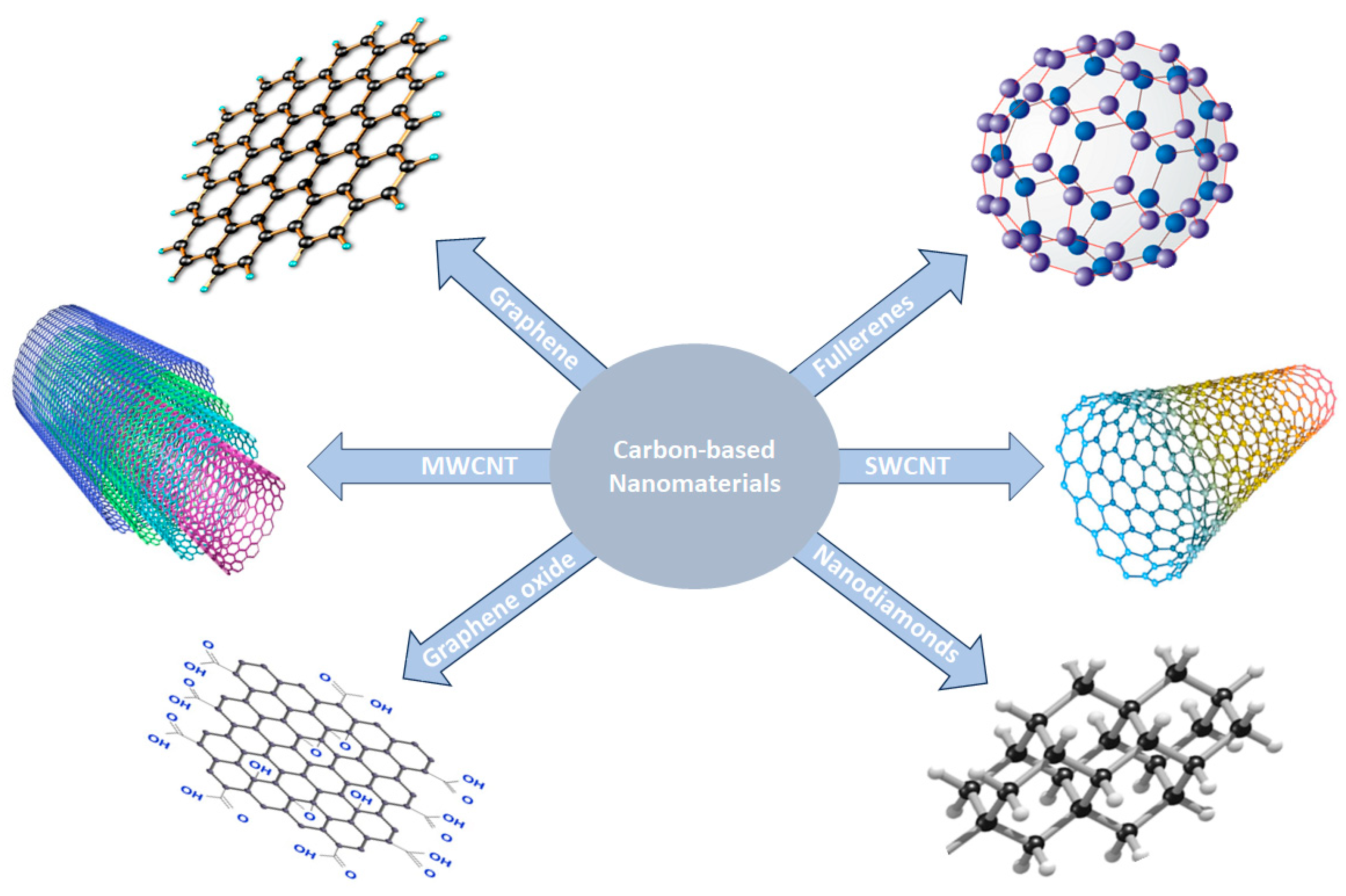

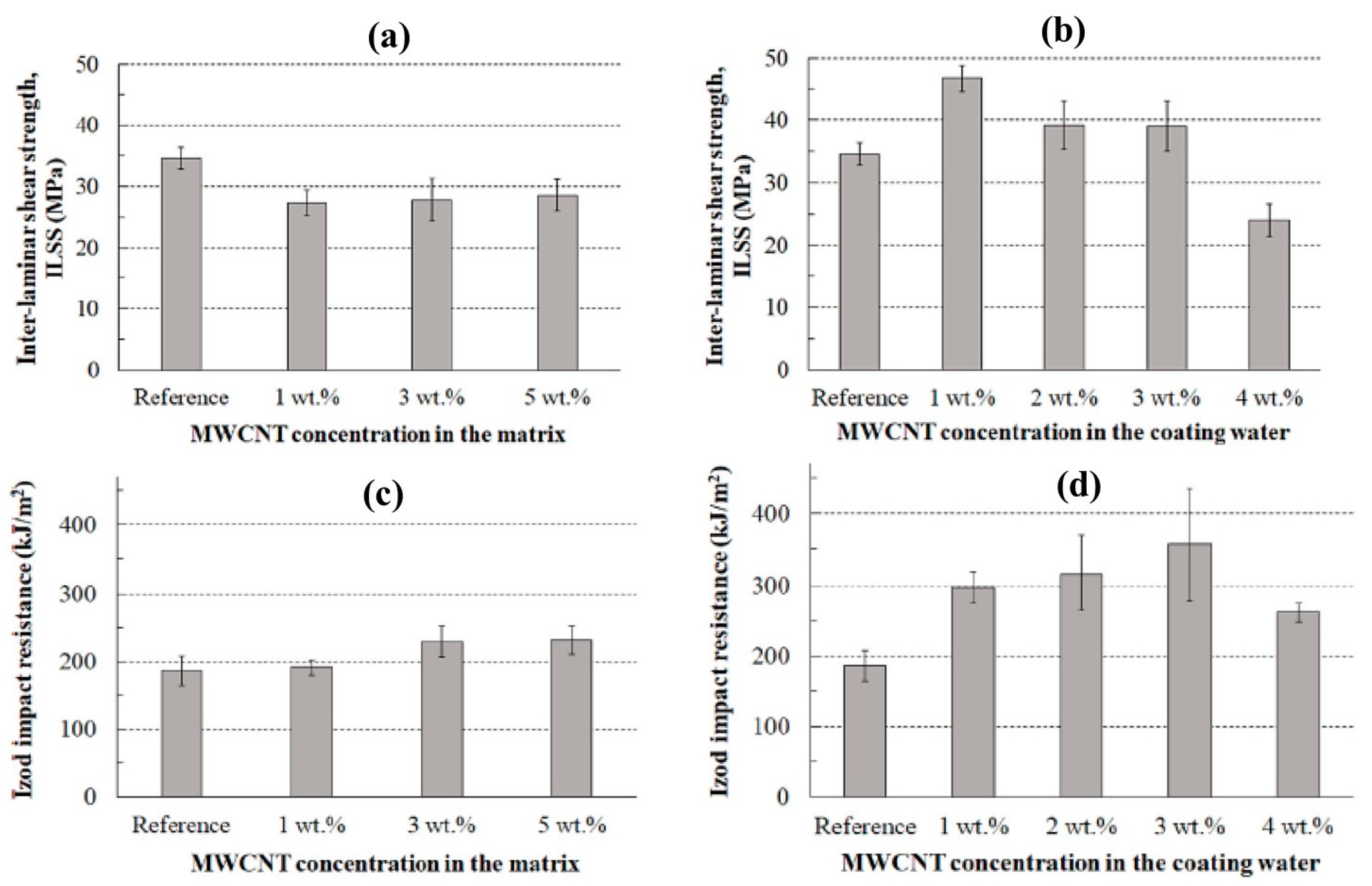

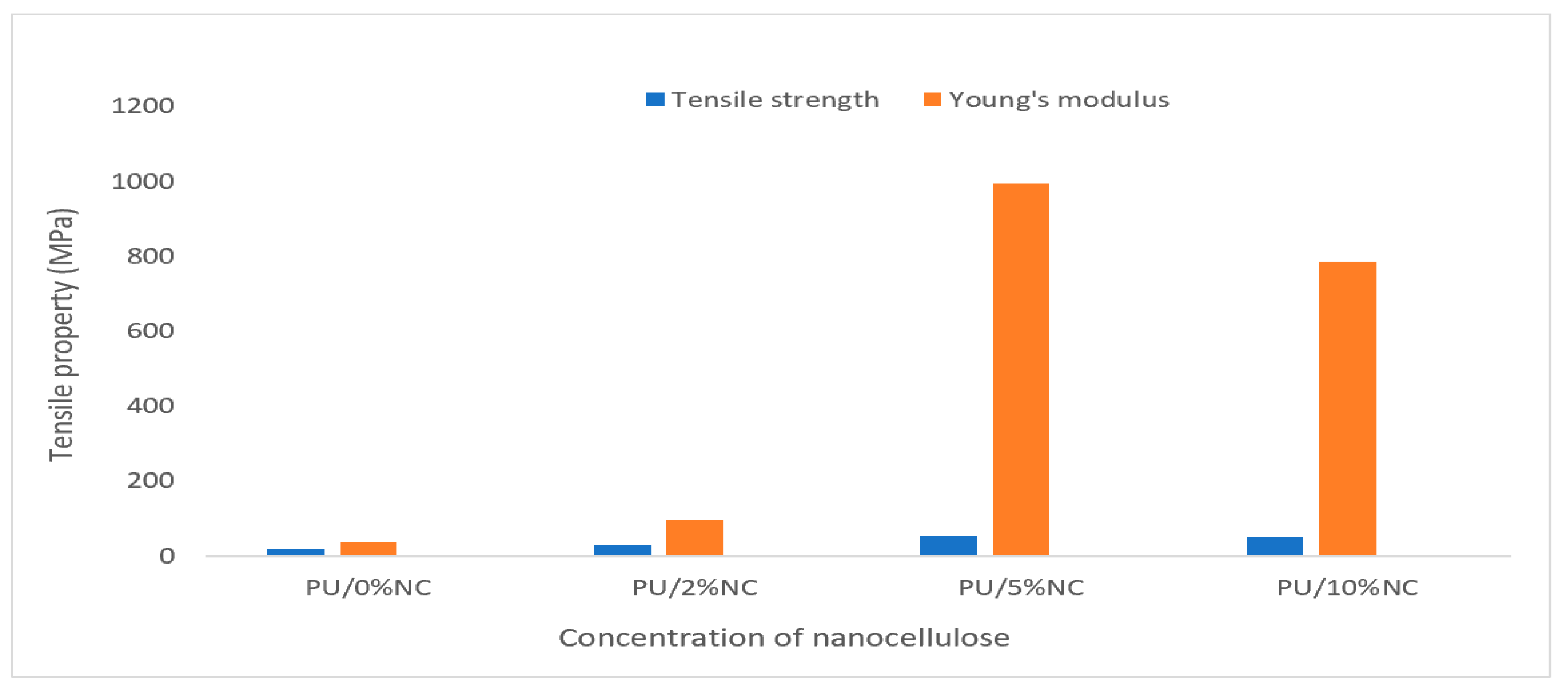

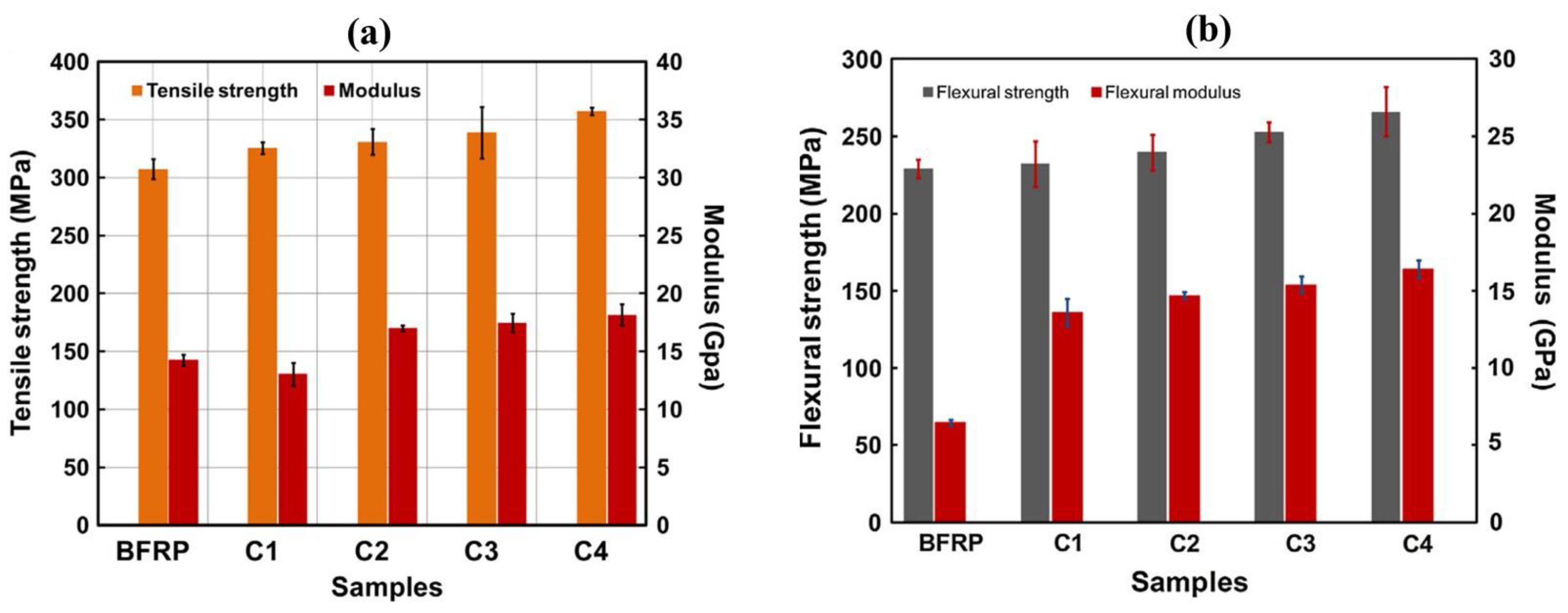
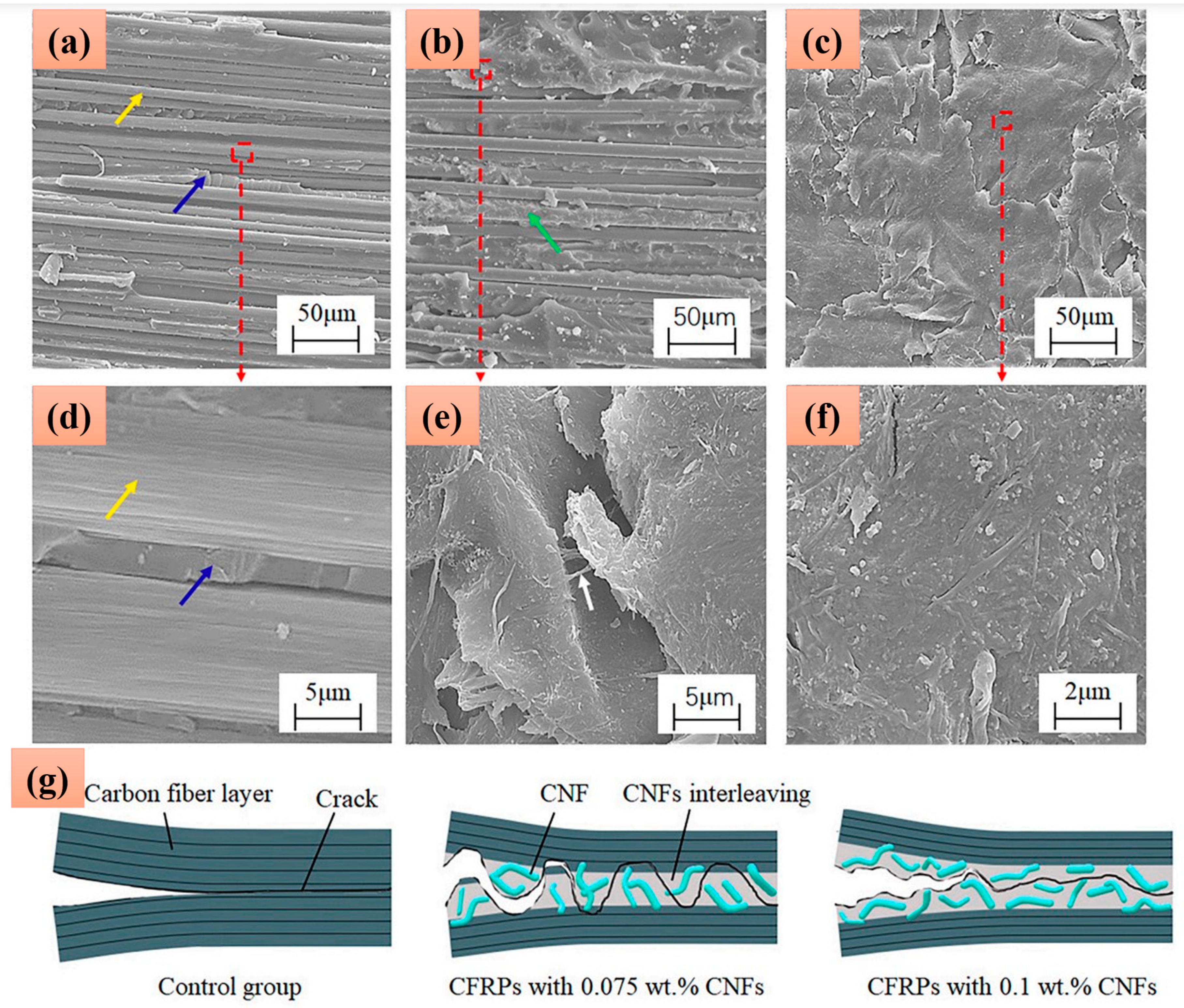
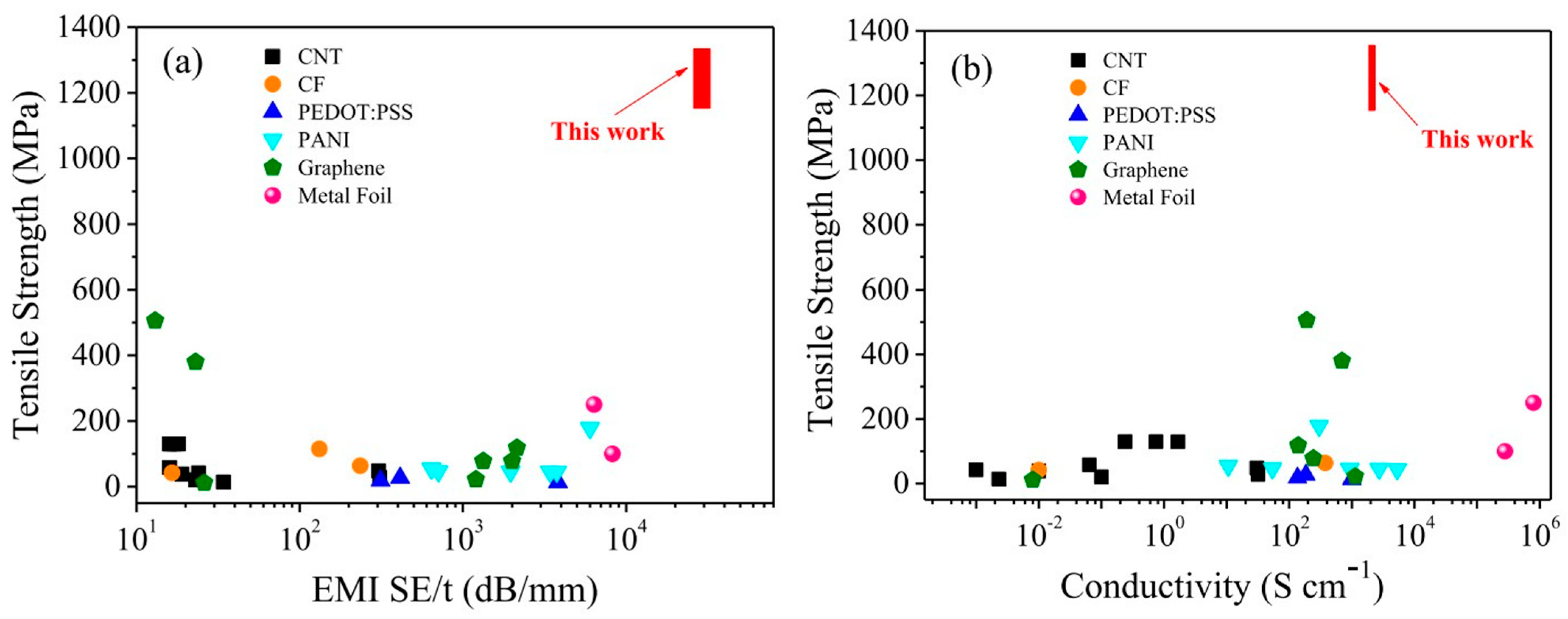
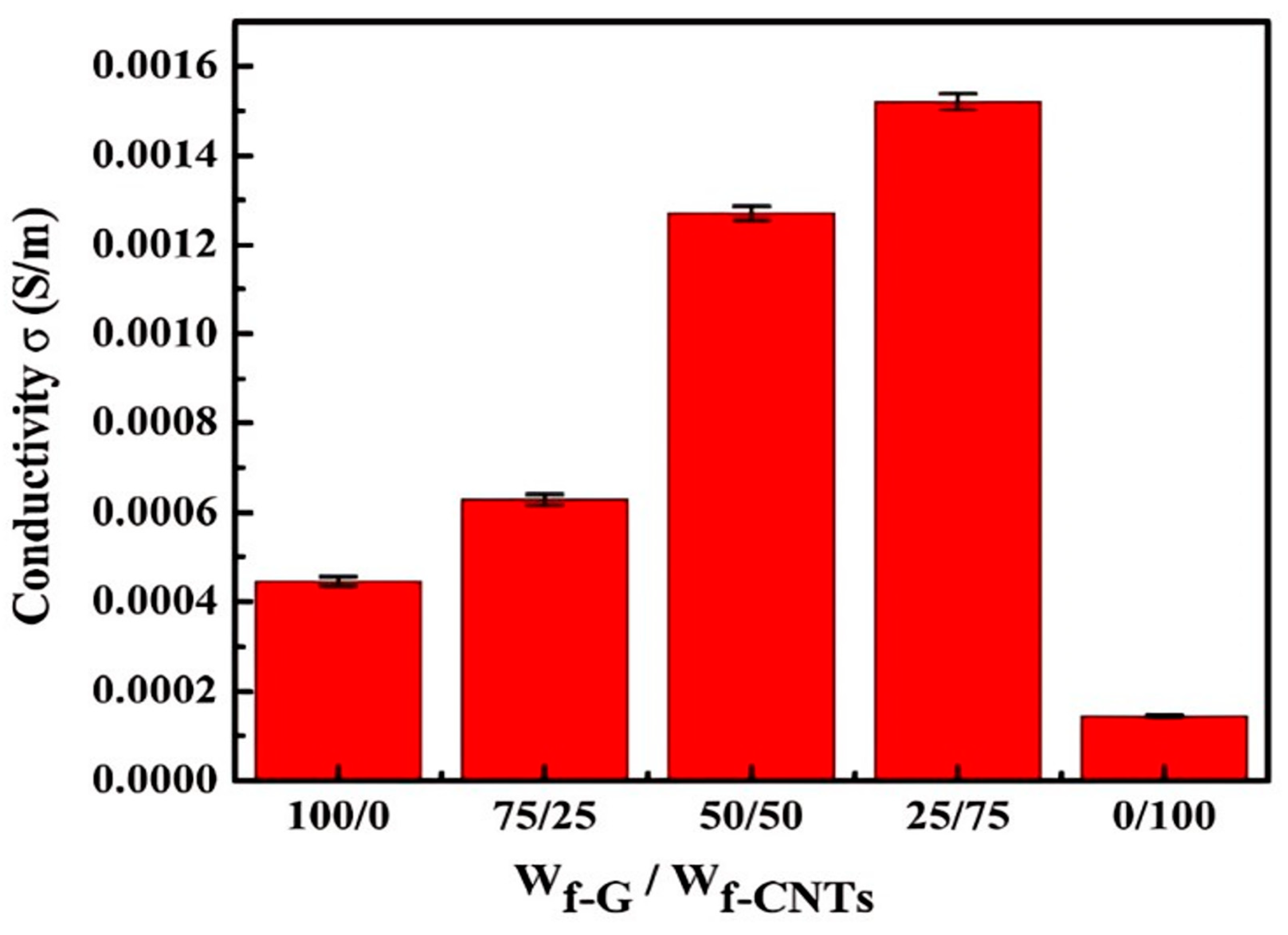



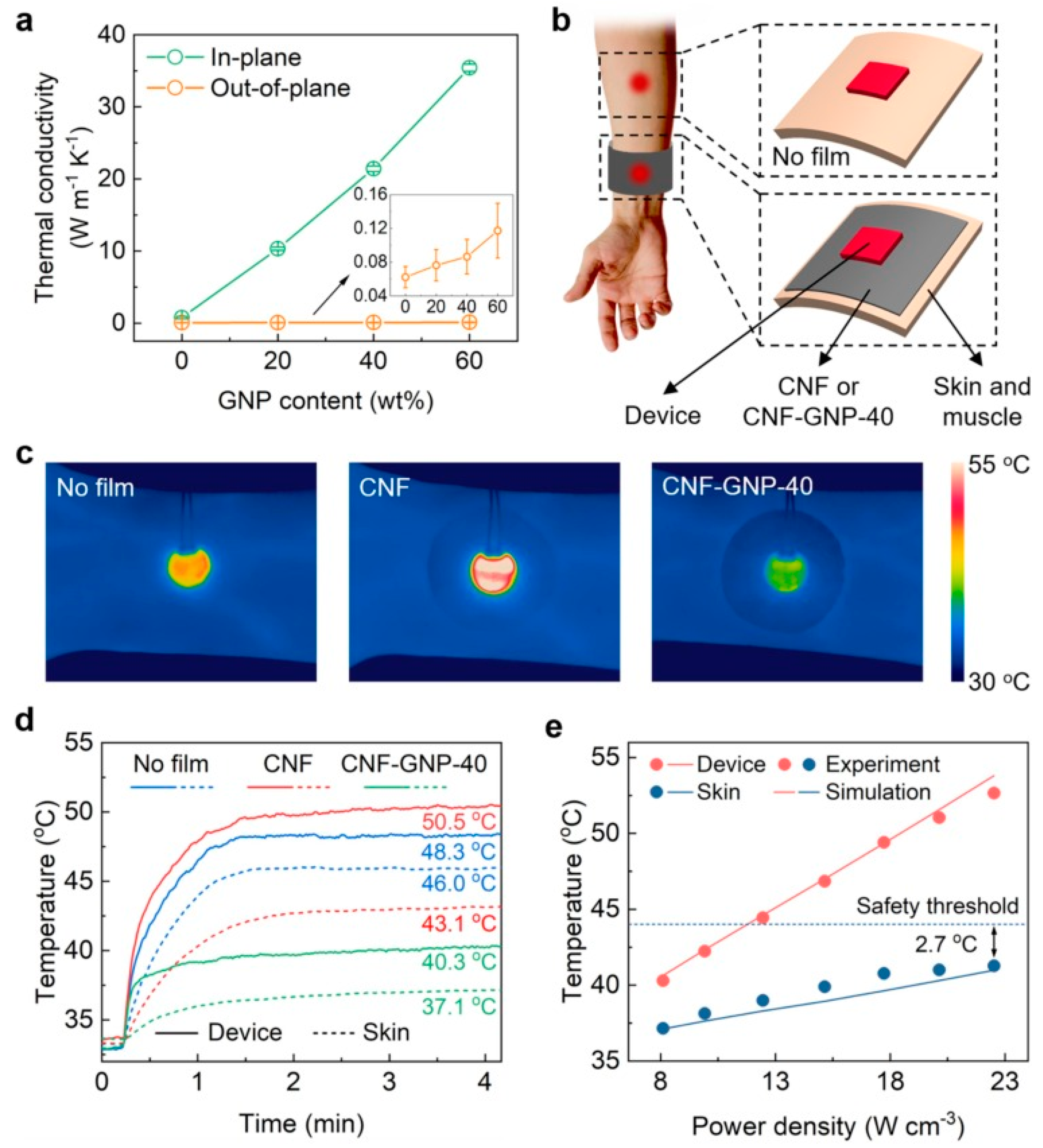

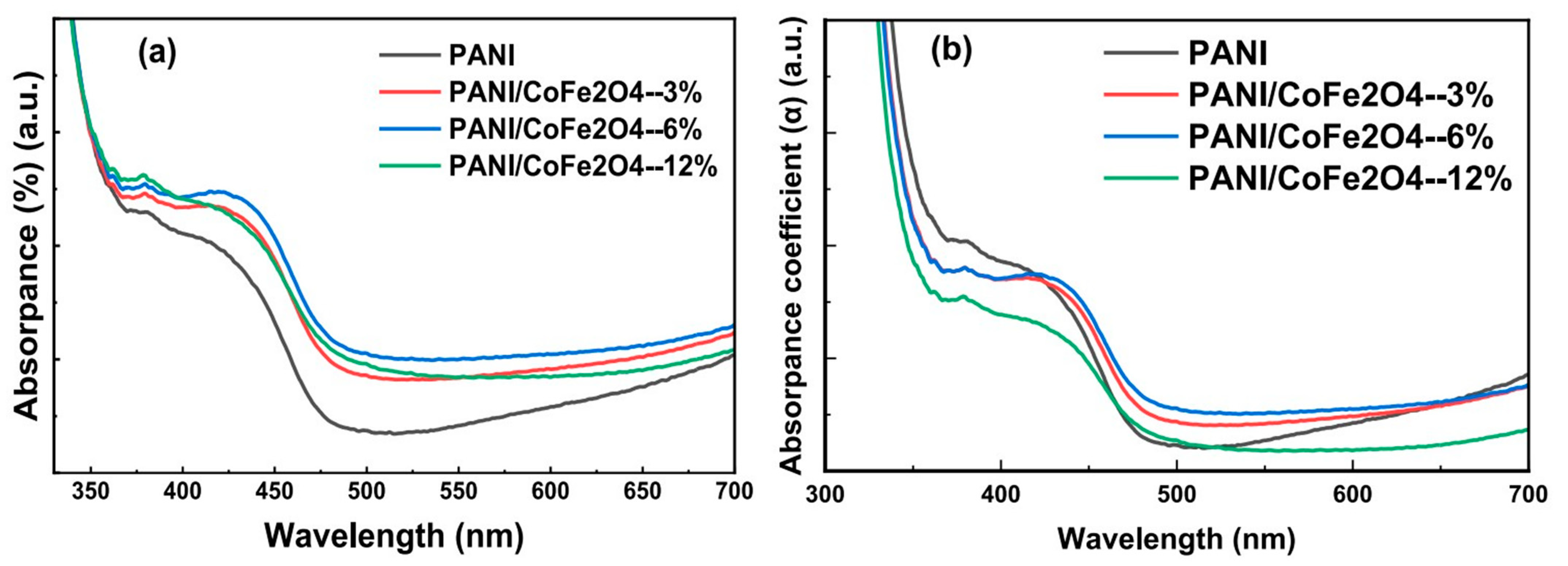

| Sample | Name Convention | Concentration of TM Particles (wt.%) |
|---|---|---|
| Basalt-fiber reinforced plastic (composite) | BFRP | 0 |
| Basalt/epoxy composite with 0.5 wt.% TM (no surfactant) | C1 | 0.5 |
| Basalt/epoxy composite with 1.0 wt.% TM (no surfactant) | C2 | 1.0 |
| Basalt/epoxy composite with 2.0 wt.% TM (no surfactant) | C3 | 2.0 |
| Basalt/epoxy composite with 1.0 wt.% TM (with surfactant) | C4 | 1.0 + surfactant |
| Nanocomposites | Area of Application | Performance Evaluation | References |
|---|---|---|---|
| Nanofiltration membranes (NF) made of a thin layer of graphene oxide (GO) and Zn-based metal-organic framework (ZIF-7) nanocomposites deposited on chitosan (CHI)-coated polyethersulfone (PES) | Wastewater treatment | The modified nanocomposite membrane with GO-ZIF-7 demonstrates a superior dye removal efficiency of approximately 94%, surpassing the original CHI-coated membrane, which achieved around 84% removal. | [184] |
| Pure low-density polyethylene and titanium dioxide nanoparticles (P-LDPE/TiO2-NPs) | Food packaging | The nanocomposite films exhibited significant improvements in mechanical properties, antibacterial activity, and permeability measurements. These enhancements demonstrate their promising potential for application in perishable food packaging. | [185] |
| Graphene/chitosan/polyvinyl alcohol (G/CHI–PVA) | Wound healing | The study demonstrated graphene’s potential as an antibacterial material, which proves beneficial for expediting wound healing. This is achieved by hindering the multiplication of prokaryotic organisms, as observed in the body systems of mice and rabbits. | [186] |
| Carbon nanotubes (CNTs) functionalized with polyaniline (PANI-CNTs), grafted on CoNi(PO4)2 (PANI-CNTs/CoNi(PO4)2 | Asymmetric supercapacitor | The hierarchical structured CoNi(PO4)2 with a mass of 40 mg of PANI-CNTs (CNP40) exhibited an enhanced specific capacity of 1268 Cg−1 (2136 F g−1 at 1.5 F g−1) while demonstrating excellent diffusive behavior (b = 0.5). | [187] |
| Molecularly imprinted polymers (MIPs) doped with SWCNT and POSS | Drug delivery | MIPs containing POSS and SWCNT showed superior controlled release in vitro. In vivo studies revealed that POSS-SWCNT MIP reached maximum plasma concentration after 4 h, exhibiting a significantly higher AUC0-9 (544.73 ng h mL−1) compared to control MIPs and NIP (327.48, 212.91, 230.35, and 275.13 ng h mL−1 for POSS MIP, SWCNT MIP, MIP, and POSS-SWCNT NIP, respectively). | [188] |
| MWCNT functionalized PAMAM dendrimer (d-MWCNT) reinforced with strontium-substituted hydroxyapatite HAP (SrHAP) (d-MWCNT-SrHAP) | Bone tissue engineering | The composite demonstrated a significant increase in curcumin loading and delayed release compared to SrHAP, and in vitro studies with human osteoblast-like cells indicated enhanced osteoblast activities. The findings indicate that d-MWCNT-SrHAP-C holds promise as an effective drug delivery system for applications in hard tissue engineering. | [189] |
| Carbon fibers (CFs)/multiwalled carbon nanotubes (MWCNTs) | Artificial wearable electronics | The hierarchical composites exhibit outstanding attributes, including enhanced high-pressure sensing (42.7 kPa), rapid response (relaxation times < 100 ms), a broad working range (0–60 kPa), and excellent stability over 6000 cycles. Additionally, the composites exhibit high thermal sensitivity (2.46 °C−1 between 30 and 40 °C), highlighting their potential in multifunctional wearable electronics. | [190] |
| Biphasic polyolefin system, consisting of macro-polyethylene (PE) phase, micro polypropylene (PP) phase, and nanostructured graphene (PE/PP/G) | Lightweight transportation industry | The newly developed nanocomposite exhibits remarkable thermo-mechanical properties, making it a potential lightweight thermoplastic olefinic nanocomposite suitable for the transportation sector. | [191] |
| Polypropylene (PP)/graphene composites (PP/G) | Electronic and thermal management | The composite material achieved a significantly high through-plane thermal conductivity of 10.93 W·m−1·K−1, approximately 55 times greater than pure PP. It demonstrates exceptional heat dissipation properties, making it suitable for use in LED integration for efficient thermal management. | [192] |
| Nanoclay, montmorillonite (MMT)/chitosan (Cs) biopolymer matrix | Bioelectricity generation and wastewater treatment in microbial fuel cells | The addition of MMT in the Cs matrix demonstrated enhanced performance in terms of power generation and chemical oxygen demand (COD) removal. The results showed that biopolymer Cs-based nanocomposite incorporated with MMT can be effectively used as an alternative for bio-proton exchange membrane in microbial fuel cell applications. | [193] |
| RGO-based SiO2-TiO2 nanocomposite | Supercapacitor for energy storage devices | The RGO-SiO2-TiO2 supercapacitor exhibited a maximum energy density of 35 Wh/kg at 630 W/kg power density, maintaining 84% capacitance stability after 10,000 cycles. This approach offers a cost-effective solution for mitigating CO2 emissions and creating efficient energy-harvesting devices. | [194] |
| Carbon nanotubes/nickel sulfide/cobalt sulfide (CNTs/NiS/CoS) nanocomposites | Supercapacitor applications | The CNTs/NiS/CoS nanocomposite displayed significantly lower impedance compared with CNTs alone. In a 3 M KOH solution, it exhibited a specific capacitance of 1249.88 mAh/g at 1 A/g, retaining 97.17% after 8000 cycles. Notably, the composite demonstrated impressive energy density (624.44 Wh/kg) and power density (8325.87 W/kg), emphasizing its potential for high-performance supercapacitor applications. | [195] |
Disclaimer/Publisher’s Note: The statements, opinions and data contained in all publications are solely those of the individual author(s) and contributor(s) and not of MDPI and/or the editor(s). MDPI and/or the editor(s) disclaim responsibility for any injury to people or property resulting from any ideas, methods, instructions or products referred to in the content. |
© 2024 by the authors. Licensee MDPI, Basel, Switzerland. This article is an open access article distributed under the terms and conditions of the Creative Commons Attribution (CC BY) license (https://creativecommons.org/licenses/by/4.0/).
Share and Cite
Musa, A.A.; Bello, A.; Adams, S.M.; Onwualu, A.P.; Anye, V.C.; Bello, K.A.; Obianyo, I.I. Nano-Enhanced Polymer Composite Materials: A Review of Current Advancements and Challenges. Polymers 2025, 17, 893. https://doi.org/10.3390/polym17070893
Musa AA, Bello A, Adams SM, Onwualu AP, Anye VC, Bello KA, Obianyo II. Nano-Enhanced Polymer Composite Materials: A Review of Current Advancements and Challenges. Polymers. 2025; 17(7):893. https://doi.org/10.3390/polym17070893
Chicago/Turabian StyleMusa, Abdulrahman Adeiza, Abdulhakeem Bello, Sani Mohammed Adams, Azikiwe Peter Onwualu, Vitalis Chioh Anye, Kamilu Adeyemi Bello, and Ifeyinwa Ijeoma Obianyo. 2025. "Nano-Enhanced Polymer Composite Materials: A Review of Current Advancements and Challenges" Polymers 17, no. 7: 893. https://doi.org/10.3390/polym17070893
APA StyleMusa, A. A., Bello, A., Adams, S. M., Onwualu, A. P., Anye, V. C., Bello, K. A., & Obianyo, I. I. (2025). Nano-Enhanced Polymer Composite Materials: A Review of Current Advancements and Challenges. Polymers, 17(7), 893. https://doi.org/10.3390/polym17070893






